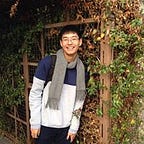There’s plenty of innovative and useful stuff going on with the designs in the article if you take a moment to think creatively. Here, let’s take a look —
This is a screen for ordering food, which is something that many apps do and do well. The UI here is rather limited: you can only swipe left and right and make an order. While that’s not good for many traditional media, it seems like a great solution for devices where interaction is limited anyway — like a TV or watch. I have not seen such a TV/watch app in the wild — if anyone has, please send it to me.
Again, another useless card interface. Or is it? I think this design is a nice experiment of the sizes and placement of pieces of information. The three most prominent pieces of information — name, picture, and affiliation (indicated by the color theme) are indeed the pieces of information that most users would want to see first, with more fine-print details for experts.
This looks like a great interface for any application where the user needs to get some basic info quickly. Perhaps messenger apps could show contact info on the side like this — it would be very peripheral vision-compatible. Also this design is great for physical ID, medical, and business cards, well, perhaps with the picture completely inside the card.
I see some nice work here. Comparing this to similar screenshots I found, this one looks much cleaner. There are a lot of good aspects that a lot of the good designs have — a landmark as the background (for quick city identification), the use of familiar symbols to express a temperature range rather than “high” and “low”, and, again the use of cards.
However, this design stands out in that it looks extremely uncluttered, mostly because it minimizes the amount of chrome: there are no shadows and borders, and there is not a single line that does not convey information. Despite this, the card still remains very understandable even for noobs.
This looks like a great concept of a site for tourists. Lots of existing tourist sites look nice at first glance but are hard to navigate, because the landing page affords both scrolling and clicking navigation links. (Two examples: sanfrancisco.travel & discoverlosangeles.com.) The design here presents a home page so simple my parents figure it out in just a few seconds. (And it looks just as pretty as the competition!)
There’s a really interesting concept here that I’ve never seen in a weather app before: very distinct and intentional color coding of cities. I’ve seen some similar concepts: color coding of weather or of time of day, and widgets like the earlier one where the cityscapes naturally have different dominant colors.
However, the colors in this design stand out, because they make finding the right city very easy. This could prove useful for frequent travelers or for a customer support staff member that deals with many different timezones.
Let’s talk about something else, something that I’ve hinted at already: Just because this is a mockup of a weather app doesn’t mean I can only use this design for making weather apps! After seeing this design, you can be sure that the next time I need to find a way to make many similar pieces of information visually distinct, I will recall how this design did it so well. This is a tip I can use for any media — not only desktop, phone, TV, watch, but also newsletters, handouts, lectures, and so much more.
By the way, even if the designs weren’t useful, I don’t think these designers should be ashamed. They are expressing themselves, and portfolio/showcase sites like Dribbble are basically platforms for people to do exactly that.
Sure, if there are 10000 weather apps out there, the one you make might not be popular if you publish it. It might — heaven forbid — be very similar to one of the existing apps out there. But why in the world should you be ashamed of making one? When creative people post their work, it shows not only their final achievements but also their journey. If making a weather app helps one become a better designer, then maybe everyone should post a weather app design on Dribbble.
Please don’t be so fast to shut down other people’s hard work as useless; it may just be that you haven’t found a use for it yet.
